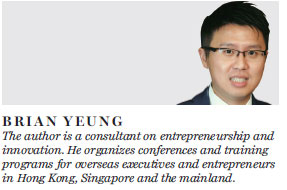Policy support is crucial to SAR's transition to a modern smart city
Updated: 2016-04-12 07:36
By Brian Yeung(HK Edition)
|
|||||||
Every city has a heart, as the saying goes. But now, the rise of the Internet of Things (IoT) may give our city a brain as well.
Internet technologies unlock a city's potential to tackle urban issues in ways previously thought impossible. The term IoT has been coined to describe how a network of connected gadgets - using sensors, wireless networks and other technologies - has become an integral part of urban life.
In Hong Kong too, the government has started to test the waters by leveraging IoT to improve urban life. As part of the Energizing Kowloon East initiative, Kai Tak has been made the pilot area of smart city projects. The Kai Tak area is similar to Singapore's Jurong Lake District, where over 1,000 sensors are installed to test various smart city technologies.
Since the transformation of Hong Kong into a smart city is already underway, what remains unclear is the role the government should play.
A smart city requires hardware. Hong Kong takes pride in its developed IT infrastructure with a high internet household penetration rate of 79 percent, according to the Thematic Household Survey Report of the Census and Statistics Department released in February. Meanwhile the mainland's internet penetration rate is only around 50 percent, according to a recent report of China Internet Network Information Center.
Despite this, the mainland appears more experimental in applying internet technologies to smart city solutions, as illustrated by its recording the second highest number of the most outstanding Smart City Initiatives in the International Data Corporation's AP Smart City Evolution Index competition last year.
Hangzhou's Integrated Smart Citizen Card is a prime example. Currently, the all-in-one smart citizen card not only covers social security, healthcare, public transportation and access to public facilities, but also lists social benefits available to cardholders based on the personal information stored in the citizen card.
Smart city needs more than hardware. Software such as government policy is the key.
One area that should top the agenda for policymakers is data privacy. Last year the Hong Kong government launched the data.gov.hk portal, in which over 5,000 data sets in 18 categories from the government were made public. The initiative is intended to encourage the use of government data for innovative applications.
The upside of open data policy such as data.gov.hk is that it allows entrepreneurs to tackle urban issues by developing smart city applications based on public data. In Singapore, for instance, startup BioMachines unveiled the web-based service uClim, which provides urban planners with real-time environmental information.
However, the government should draw a line between public services and businesses. Public datasets are funded by the taxpayers' money, so to what extent will businesses be allowed to monetize public data and resell it to taxpayers? That is indeed a question to ponder. For another thing, the government has the responsibility to ensure that public data will not be misused.
Another area worth attention is cybersecurity. If the government intends to count on entrepreneurs to come up with smart city applications, the smart city project will involve multiple vendors and some of these applications will be hosted on third-party domains, which will ultimately make the city more vulnerable to cyber attack.
Imagine one day in the future when technology allows traffic lights to operate based on real-time traffic, the potential damage of such a system being hacked would be a very serious problem. As such, when it comes to IoT and smart city, the government will have to strike a balance between innovation and security.
Finally, technology education is crucial. While a smart city requires tech-savvy talents to come up with innovative solutions, its citizens need to be "smart" enough to master smart technologies.
In Singapore, already there are applications dedicated to the elderly. SoundEye, a system that detects potential falls of an elderly person based on the distance between the person and the ceiling, is one example. SmartMat, a technology that provides medical staff with real-time health data of an elderly person, is another example.
In other words, to make smart city applications serve their purpose, technology literacy among citizens - regardless of demographics - has become more important than ever.
At this year's World Economic Forum, global experts said that the world is now facing the fourth industrial revolution, a new era defined by human-machine interdependence. IT research company Gartner predicted that the number of connected things used by smart cities would hit the 9.7 billion mark by 2020.
Notwithstanding the opportunities that IoT and smart city may bring in the future, a forward-looking policy is essential for our city's successful transition.

(HK Edition 04/12/2016 page9)